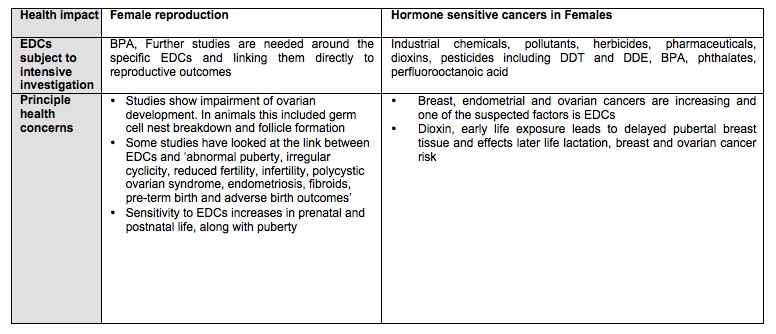Content Sections
This month has welcomed the second scientific statement on environmental Endocrine Disrupting Chemicals (EDCs) published by one of the leading academic authorities on all things endocrine (hormonal), namely the Endocrine Society. The first statement on EDCs by the Endocrine Society was published in 2009. What are EDCs, where are they found, and, with this latest review, should we be more or less concerned about them than we were?
What are EDCs?
In a nutshell, EDCs are the “exogenous chemical(s), or mixtures of chemicals, that interfere with any aspect of hormone action”. They are mostly man-made and found in various foods and materials as contaminants, pesticides, in personal-care products or as additives. Some of the most well researched EDCs include the plasticiser bisphenol A (BPA) and phthalates, as well as a wide range of pesticides and persistent organic pollutants (POPs) such as PCBs and dioxins. The primary concern is the incredibly broad distribution of these chemicals in our food, water and personal care products, and chronic, low-level exposures over our entire lifespan. For example, over 95% of us are known to show exposure to phthalates based on metabolites present in urine. There have of course been well-documented cases of very high, acute exposures, such as those associated with Agent Orange used during the Vietnam war.
As stated by the World Health Organization (WHO) “human exposure to EDCs occurs via ingestion of food, dust and water, via inhalation of gases and particles in the air, and through the skin.”
EDC-2: key findings
Since the Endocrine Society’s first review 6 years ago, the group has reviewed over 1300 new scientific articles on the subject and highlighted the main concerns in its new and second statement, referred to as EDC-2. The group focus on the 4 areas of research that have particularly added to our knowledge on this topic are:
- EDC exposure on development and physiology
- Mechanistic underpinnings of these disorders
- Links between body burdens with disease propensity
- Investigations of humans with known occupational or acute exposures to a particular chemical or group of chemicals with EDC activity
The study concluded that there was no doubt that the EDCs had serious health implications, including “chronic disease burdens related to obesity, diabetes mellitus, reproduction, thyroid, cancers, neuroendocrine and neurodevelopmental functions.” So with these health issues ever on the increase and diminishing the quality of life we have put together a summary of the findings in two summary tables (below).
Table 1: Key findings applicable to males and females from EDC-2: The Endocrine Society’s Second Scientific Statement on Endocrine-Disrupting Chemicals (click to enlarge)
Table 2: Key findings applicable to females only from EDC-2: The Endocrine Society’s Second Scientific Statement on Endocrine-Disrupting Chemicals (click to enlarge)
This is an area of ongoing research and there are certain areas such as, the effect on female reproduction and linking specific EDCs to reproductive outcomes, where further research is needed. As more and more evidence shows that even very low levels of exposure may yield adverse effects, there is also a great need for more on dose-related exposure.
Long-term implications
This report is not only eye-opening with regard to the breadth of impact of EDCs and the challenges associated with reducing exposure, but also because exposures may commence years or decades before any symptoms present themselves. At different life stages these chemicals can have different impacts and among those of greatest concern are those that impact during foetal and early life developmental stages. In early life, appropriate hormonal regulation is essential for essential development processes to occur and smaller body size also means foetuses and infants can be relatively more exposed.
The EDC-2 authors don’t hold back, providing copious evidence that human-made EDCs can dramatically alter the trajectory of natural hormones, with “too much or too little of a hormone can result in neurological impairments (eg, thyroid hormone deficiency), disorders of sexual development (eg, abnormal androgen or estrogen levels), or even death.”
So it is great that over the last 5 years that the research now provides deeper insights so that we can understand the impact of these chemicals. San Francisco banned the sale of plastic water bottles on city-owned property, helping to limit exposure to BPA, and other cities could learn a lot from this. We need to do more at a governmental level to reduce our exposure, and the impact of these health implications and the cost of them to the NHS, should drive this. For individuals, awareness needs to be raised, we need to know what chemicals we are being exposed too and what will be the impact to our health. We can then make decisions to limit this and use our buying power to change the industry to stop using them.
How to reduce your exposure to EDCs
- Download our quick reference tables
- Don’t store food or water in plastic containers or bottles, and where possible use inert materials such as glass or cardboard
- Never heat food in polycarbonate containers as BPA and other plasticising chemicals can leach into the food when heated
- Reduce the amount of canned food you eat as the tins are lined with BPA and this leaks into the food, especially more acidic produce such as canned tomatoes
- Use baby bottles and toys that are BPA free
- Don’t drink municipal tap water that hasn’t been filtered to remove EDCs (e.g. by reverse osmosis or distillation)
- Consume foods grown without pesticides (e.g. organic, biodynamic)
- Use environmentally-friendly personal care and household products that are guaranteed phthalate-free
- Avoid handling (or requesting) receipts as thermal paper is coated with BPA
- Go for organic where possible with meat, fish, milk, eggs and butter as these may be contaminated
- Use a vacuum cleaner with a HEPA filter to avoid breathing in dust/particles contaminated by EDCs
- Limit your perfluorooctanic acid (PFOA) exposure by finding non-toxic or organic dry-cleaners. If you don’t have one in your area then make sure to air your clothes in a breezy space outside of the plastic for 24-48 hours before putting in the wardrobe. This prevents this chemical gassing off in your wardrobe or on your body.
- Avoid the following in your personal care products:
- DEA (Diethanolamine)
- MEA (Monoethanolamine
- TEA (Triethanolamine)
- Phthalates and parabens
- FD&C Colour Pigments
- Imidazolidinyl Urea and DMDM Hydantoin
- Quaterium-15
- Isopropyl Alcohol
- Mineral Oil
- Polyethylene Glycol
- Sodium Lauryl Sulfate and Sodium Laureth Sulfate
- Triclosan
- Talc
- Petrolatum
If you are unsure whether they contain this then use the EWG database to check: http://www.ewg.org/skindeep/
- Buy organic, non-GMO food that is free from pesticides and herbicides. Check out the US Environmental Working Group’s expanded Dirty Dozen Plus, (kale and hot chillis added), as well as the safer Clean Fifteen
- Commercial, farmed fish are high in PCBs and DDT so buy wild, non-farmed fish
- Get rid of the nonstick pans such as Teflon to minimise PFOA exposure. Instead opt for ceramic, cast iron, stainless steel or titanium. If this isn’t financially viable at present then at a minimum get rid of those that are scratched or show sign of deterioration as this increases the leakage of these chemicals.










Comments
your voice counts
There are currently no comments on this post.
Your voice counts
We welcome your comments and are very interested in your point of view, but we ask that you keep them relevant to the article, that they be civil and without commercial links. All comments are moderated prior to being published. We reserve the right to edit or not publish comments that we consider abusive or offensive.
There is extra content here from a third party provider. You will be unable to see this content unless you agree to allow Content Cookies. Cookie Preferences